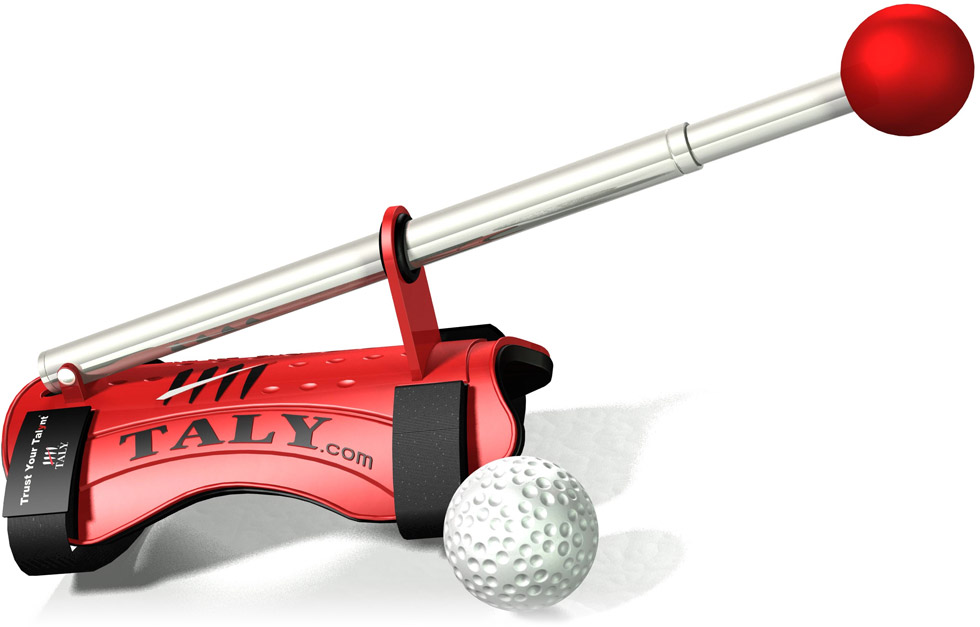 The world of golf training aids is vast. Sometimes it seems as though every serious instructor has his name on some gadget or another. Some work. Some work really well. Others do not.
The world of golf training aids is vast. Sometimes it seems as though every serious instructor has his name on some gadget or another. Some work. Some work really well. Others do not.
Then there are the guys who don’t teach golf for a living. Sonic Golf comes from a scientist. And the item pictured just above/to the right, the “Taly MIND Set,” comes from a slightly better than average golfer named Taly Williams. He’s also not an instructor.
Does that make the “Taly” (even the inventor prefers to call it the “Taly” instead of the official “MIND Set” name) better or worse than the others? Let’s find out.The General Principle
Nicknamed the “Clown’s Nose,” the Taly’s key function is to assist golfers in achieving a proper impact position. No doubt you’ve heard of the problems of “casting” and “flipping” (or “clubhead throwaway”). These swing faults seem to arise in every golfer, and a big part of advancing as a golfer is eliminating those two flaws.
Lynn Blake, a well-known instructor, calls the Taly one of the best devices he’s ever seen in this short video which will do more to explain the general role of the Taly than I can in a few hundred words:
As you saw, the Taly’s basic, key use is as a visual aid to keep the handle leading the clubhead through the golf ball. This creates positive shaft lean and, unless you chicken-wing the bejeezus out of the ball, properly puts the low point on the target side of the golf ball.
The device itself is essentially a child’s soccer shin guard with a telescoping aluminum rod capped by a soft red ball. The aluminum rod measures anywhere from about a foot to over 30 inches, and the shin guard – which you place on your forearm – is about six inches in length. The small arm that holds the aluminum rod out at an angle can collapse to save a little space.
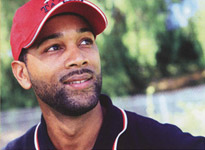 Using the Taly is simple: you strap it on to your arm with the two included velcro/elastic strips, you position it where you’d like, and you slide the clown nose portion out as far as you’d like. If you’re performing the basic drills, the included instructions tell you how to position the Taly. In addition to the directions, the Taly ships with a two-sided clip so you can carry it on your golf bag if you’d like.
Using the Taly is simple: you strap it on to your arm with the two included velcro/elastic strips, you position it where you’d like, and you slide the clown nose portion out as far as you’d like. If you’re performing the basic drills, the included instructions tell you how to position the Taly. In addition to the directions, the Taly ships with a two-sided clip so you can carry it on your golf bag if you’d like.
The standard elastic strips are just long enough. My forearms aren’t beefy and I’m not overweight, and I know you want a tight fit so the Taly isn’t sliding around. It’s nice that there aren’t any extra straps or pieces flapping around, but for $79, it might be nice to include the smaller and larger versions of the straps instead of charging an extra $9.95.

The Taly comes in three colors: white, red, and black. The more metrosexual golfer will appreciate the options this gives him, though I’ve heard you’re not supposed to use white training aids after Labor Day…
Taly In Use
Again, given that perhaps 95% of golfers flip the clubhead at the ball, most golfers could buy a Taly, use it exactly as Lynn Blake demonstrated in the video above, and likely see an improvement right away.
Starting with slow swings, the Taly provides a powerful visual reminder not to flip the clubhead at the ball. If you do, the clubhead will go past the Taly’s clown nose. Instant, obvious feedback.
As you work up to faster swings (and as you start to look at a ball on the ground instead of the clown nose), the Taly shifts from being an actual visual image into more of a mental image.
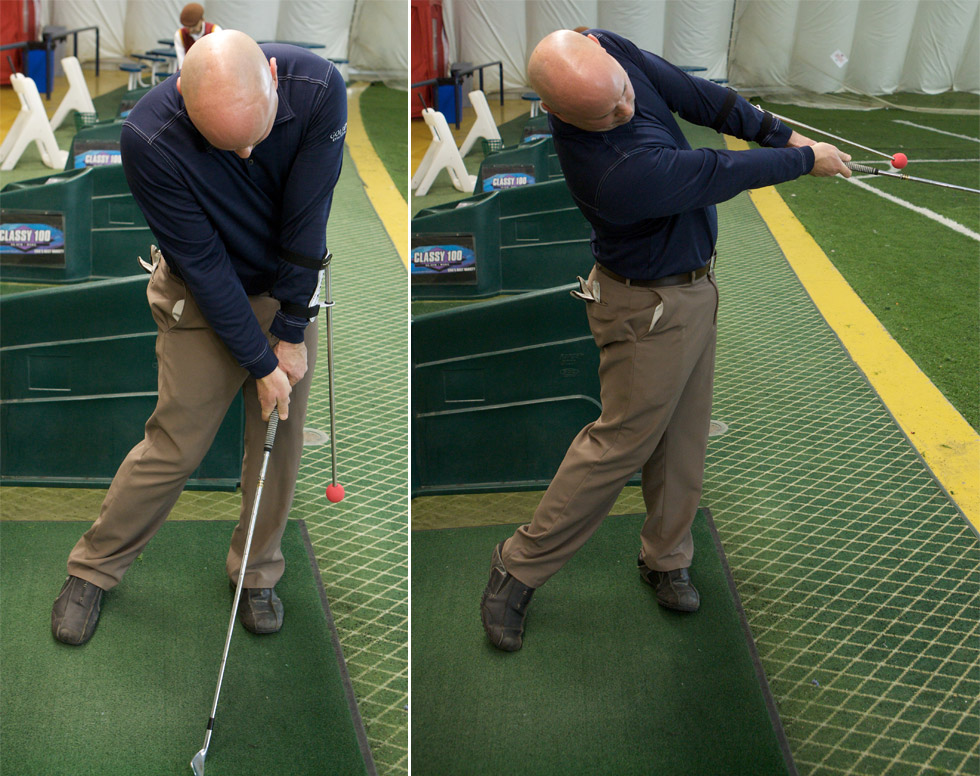
Dave demonstrates impact and the follow-through with a Taly. The clubhead never flips past the red “clown nose” at the end of the Taly.
Using Taly Williams’ suggestion to have golfers hit ten shots with the Taly on and ten without the Taly, I saw fairly dramatic improvement in the half dozen golfers I tested. Some were able to make full swings right away, but some needed to start with shorter “chipping” or “punchy” shots in order to really get the visual feel down before switching to a more mental picture with faster swings.
But in each case, the impact positions of the golfers improved, often a starting amount.
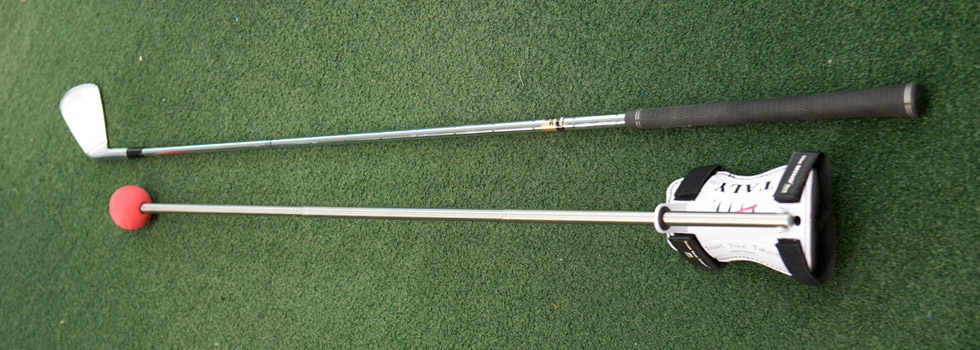
Fully extended, the Taly is still shorter than a 6-iron. It squeezes down to about one foot in length.
If the Taly did nothing else but ensure a proper impact position and no flipping, you could likely chalk it up as a win. After all, impact is the only real moment of truth in the golf swing, and a flat left wrist without casting or flipping is paramount to playing decent, good, or great golf. The Taly may be the best device I’ve ever seen for maintaining a flat left wrist leading into and through impact.
Yet the Taly will do more, and in some ways, what it can do is limited only by your imagination. For example, check out this image:
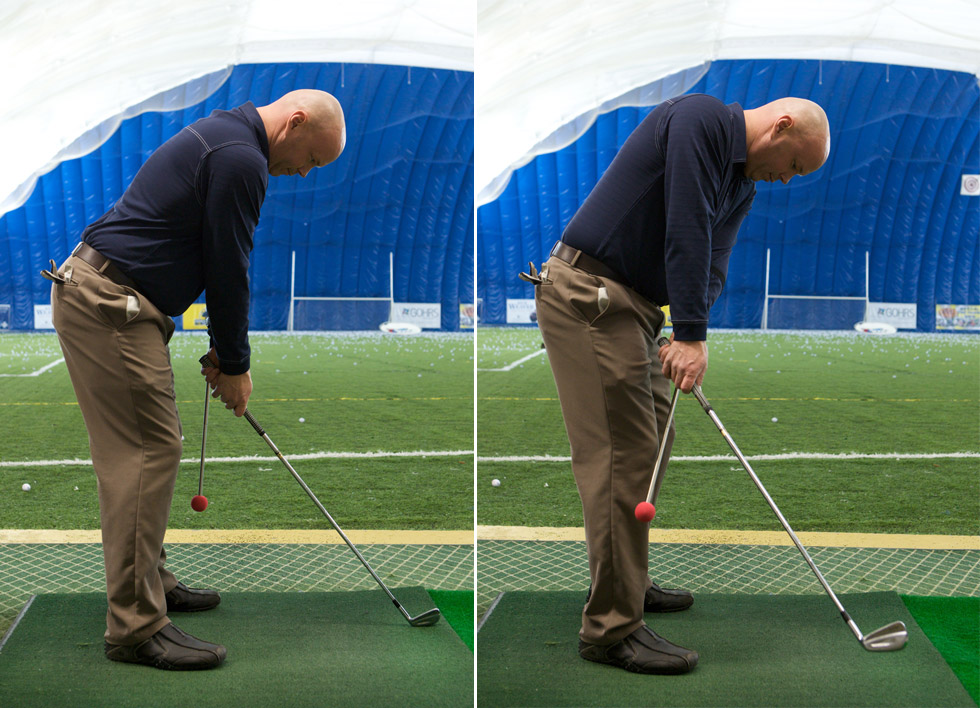
We discovered that, if adjusted properly, the clown nose would brush against your right thigh when your hands properly moved back, in, and up on the takeaway.
This down-the-line view shows how the Taly hangs at setup. My instructor and I discovered that, if adjusted to the proper length, the clown nose would brush against your right thigh or knee on the takeaway if your hands moved properly on the arc back, up, and in. If you’re prone to taking the club away by shoving your hands away from your body or rolling the clubhead behind you, the clown nose will likely miss your leg.
For those who over-rotate and whip the clubhead well behind the hands on the takeaway, putting the Taly on the right forearm and keeping the club shaft from swinging around behind it can be beneficial.
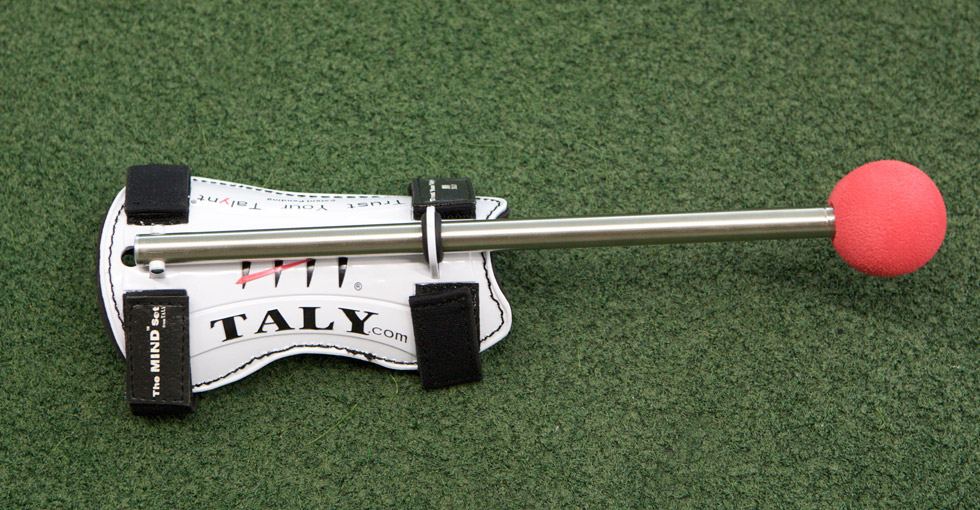
The Taly in its flatter state (above) or extended for use (below). I have a white one. 🙂
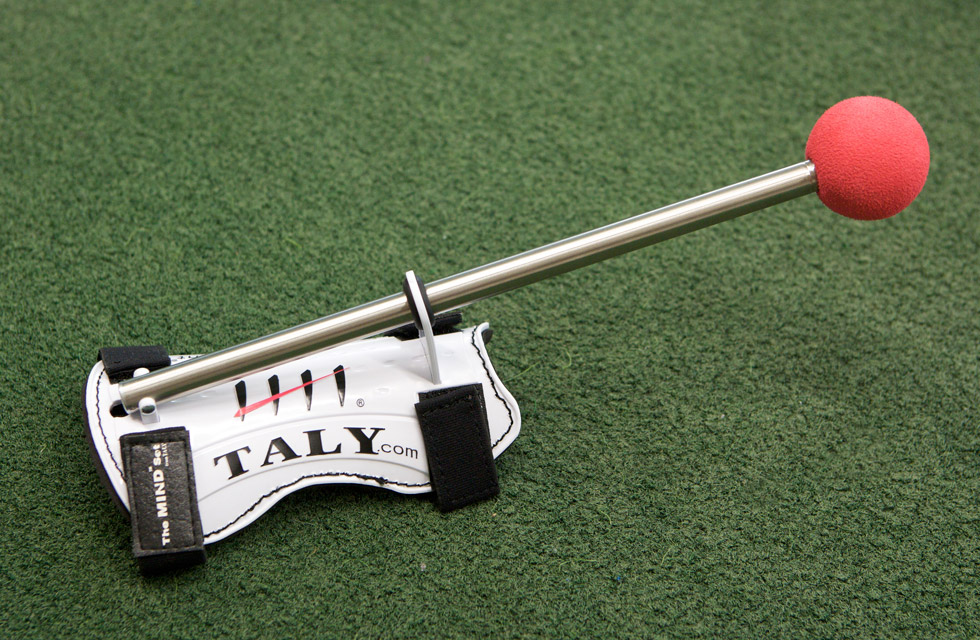
At the top of the backswing, the Taly can provide a powerful visual aid for students working on their plane, whether they’re going more upright or, more commonly, a bit flatter. I’ve even attached the Taly across my left elbow to check whether my left arm was folding a little in my backswing. In that instance, I wasn’t really using the clown nose, but the rigid shin guard portion.
If you’re having trouble coming over the top, the Taly might be able to help you, too. If you envision the clown nose coming down from the inside and passing over the ball on a slight in-to-out path, the clubhead will surely follow.
The Taly has other uses too. It’s a natural fit for most short-game shots. Phil Mickelson wants everyone to “hinge and hold” and the Taly is perfect for that.
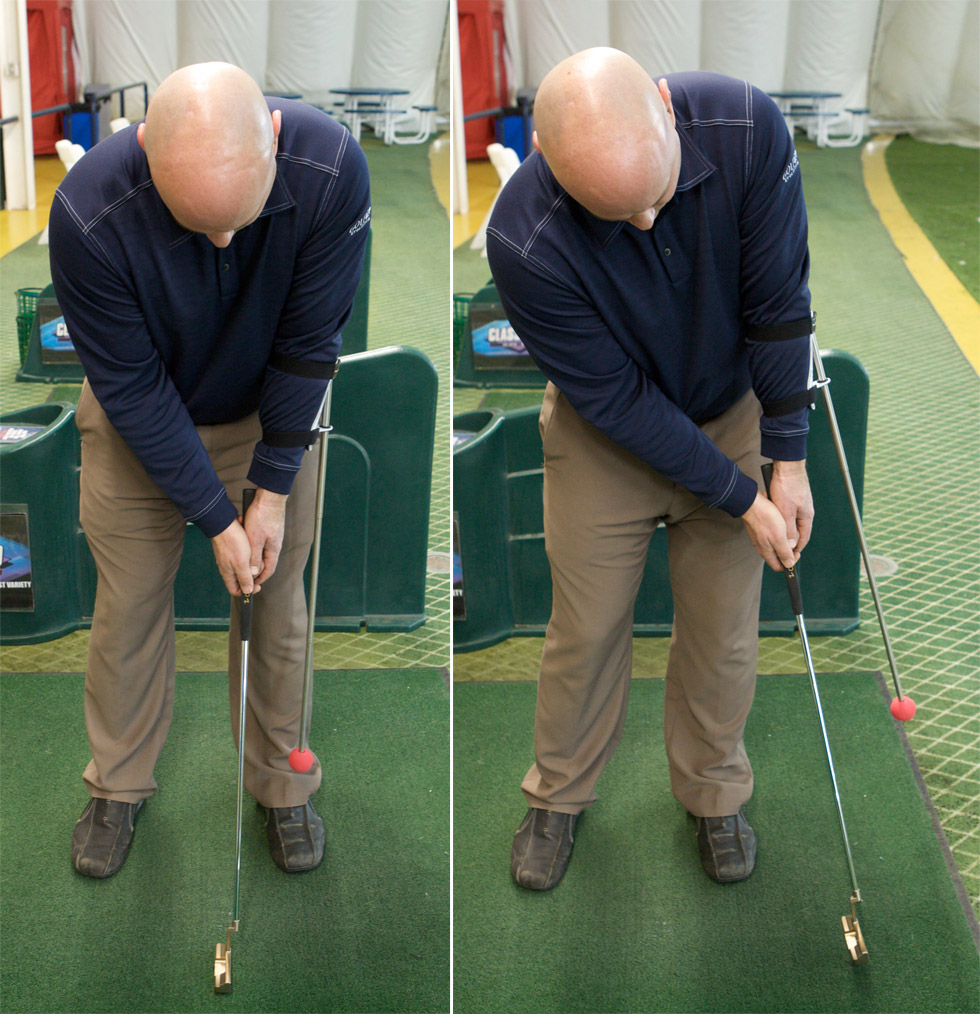
If you prefer a wristless putting stroke, the Taly again helps you to maintain a flat left wrist. You can even use the Taly as a tempo aid – just make the clown nose move back smoothly, pause, and come forward smoothly.
Conclusion
The Taly does a wonderful job of teaching a couple of things. It teaches a flat left wrist at impact (and beyond). By proxy, it also teaches another important concept – the “left side connection” or Pressure Point 4. You see, the only way to properly use the Taly is to maintain the connection between your left arm and your chest. Lose that connection and you’ve chicken-winged it or swung well out to the right.
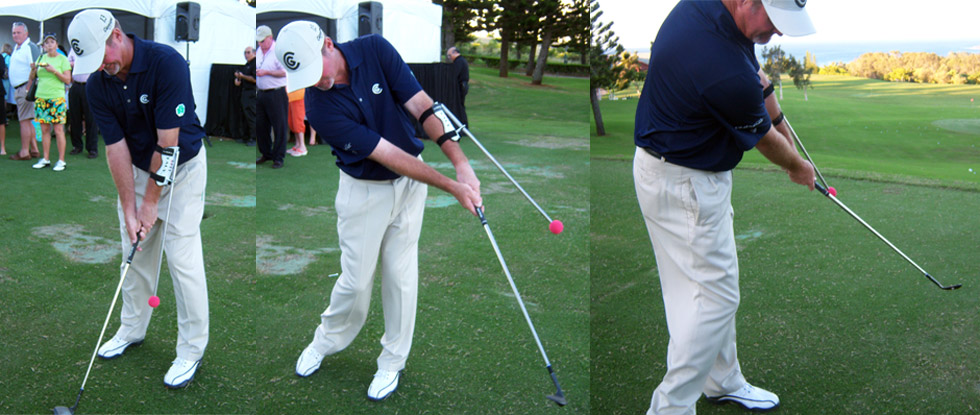
Jerry Kelly is a Taly fan. He’s had one tucked inside his bag for several months.
Yes, you can achieve the latter by sticking a tee or a glove under your left armpit when you swing, but if you – like 95% of golfers out there – need a flatter left wrist at impact, the Taly may be the best $79 you’ve ever spent.
A Quick Word on the Price
I accidentally published this review last week, and in the hour or so it was online, every one of the five comments picked at the Taly’s price.
I’ve previously highly recommended via review a training aid that cost $300. The Z-Factor continues to be one of the best training aids on the market.
I feel similarly with the Taly. A flat left wrist at impact is so critical to a good golf swing that every golfer should strive to achieve that position, and the Taly is likely the best training aid out there to do it. Pros use training aids all the time.
The improvements I saw in the group of golfers I tested was significant and rapid. Lessons cost $50 to 100/hour (or more), putters cost $100 to $300, and two dozen premium golf balls costs more than the $79 the Taly costs. If you’re serious about your golf game, you know the value of a good training aid, and the Taly is a good training aid.
My only concern is vanity..i bought some golf stuff years ago at a clearance outlet and to be nice the guy threw in a free training aid. at home the aid worked pretty good, but the moment i got on the range and realized people near me were curious on the thing i was using, i felt silly.
Should i worry what people think? no.
but the idea of swinging a clown nose on a stick at the local range has me a bit vain and embarassed.
I was one of the original posters who mentioned price. Here’s a training aid that makes the Taly look cheap: http://smartstickgolf.com/. It does have lasers, but you’re not swinging a real club with it – I would prefer the Taly to this, but I’m sure I saw a homemade solution, definitely not as good as the Taly, somewhere on a Golf Channel video.
This looks like a great device but the price is a little hard to get over. $50 seems more appropriate.
I think it looks like an interesting training aid. It seems like a tool that takes an idea that could easily just be a swing thought but would help people who have trouble visualizing.
People bitching about the price should take up another sport. If it’s not worth the cost to you, here’s a shocking idea: don’t buy it.
The Taly is the best training aid on the market. It’s worth its weight in gold to me. I first picked one up after reading a few posts, like this one at R3J’s site.
The first imperative in a good golf swing is a flat left wrist at impact. The Taly’s the best way to get it. If you can’t keep a flat left wrist at impact, you can’t play good golf. End of story.
If you don’t want to spend $79, but a metal one foot ruler and strap it on the back of your left wrist. THAT will keep you left wrist flat at impact. If that is too expensive, a couple of rubber bands and a BIC pen also works.
Another great review. The Sand Trap is one of the best review sites on the web. You guys do a terrific job in providing objective insight into equipment. Keep up the good work!!
I made my own. I used one of those putter clips that go on the side of your bag like a big clothes pin and slid it under my glove with the attachment groove up. I then broke of a small ball retriever to fit into the groove and be my aiming point. The clip works great to physically keep your wrist straight and the the ball retriver with its white basket is a good aiming Taly point. Under $10. P. S. I made this before I heard of Taly
anyone know if this can be used by the lefthanded golfer